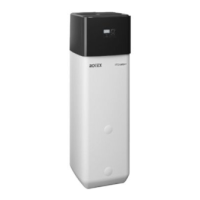2 x Operation
FA ROTEX RoCon HP - 03/2013
13
Function heating
Function heating verifies that the installation is fault-free for the
heating engineer. A pre-printed heating up report, referring to
ROTEX underfloor heating can be found at the internet portal at
http://www.rotex.de.
In this case, function heating (identical with "Heating up" in
EN 1264, section 5.2) does not constitute a heating up process
for drying and curing. Normally you need to carry out separate
heating process to cure the floor and/or perform mechanical
drying.
Heating up should be carried out no earlier than after 21 days for
cement screed, and no earlier than after 7 days for anhydrite
screed in accordance with the details provided by the manufac-
turer. The first heating up starts at a feed temperature of 25 °C,
which must be maintained for a period of 3 days. Then heating is
carried out at the maximum flow temperature set for the heating
circuit (limited to max. 55 °C) and this is then held for a further
4 days.
As a result of the insulating effect of the DUO heating pipe on
System 70, the screed function is carried out at higher tempera-
tures. On System 70, the heating up starts at a temperature of
38 °C, which is held for a period of 3 days. After that, the set
maximum heating circuit temperature (limited to 70 °C) is held for
4 days.
After the heating up process described, there is no guarantee that
the screed has achieved the moisture content required to cure
the floor.
You must determine the moisture content in the screed by
measurement before laying the floor covering.
Ready-to-apply heating
The drying out procedure for the screed cannot be predicted
exactly in advance. At higher humidity levels in the air this can
come to a complete stop under certain circumstances. The drying
out process may be accelerated by running the underfloor
heating (curing heating) or by using measures such as
mechanical drying.
Every curing heating process must be commissioned separately
by the building owner as an extra service in accordance with
VOB. For the flooring contractor to achieve fault-free installation,
the flooring must be properly cured before work is started on the
top flooring layer.
The standard functions shown in the following illustrations for
curing heating can be adjusted in order to achieve a residual
moisture level in the screed required by the curing process. The
residual moisture level in the screed must, however, always be
checked by measurement before the floorcovering is laid.
More detailed explanations and possible setting values for this function can be seen
in chapter 3.2.
2.4.7 Whisper mode
Whisper mode means that the exterior heat pump unit is
operating at reduced output. This reduces the operating noise
caused by the exterior heat pump unit.
The whisper mode is set and turned off as follows:
Ɣ Place the rotary switch in the "Configuration" position.
Î An overview is displayed.
Ɣ Select the "System Configuration" level with the rotary switch.
Î An overview is displayed.
Ɣ Select the parameter [Quiet Mode] with the rotary switch.
Ɣ Select and change the value to be changed within the
individual display using the rotary switch.
Ɣ Confirm the changes with a brief push of the rotary switch.
Î Change has been accepted. Jump back to previous dis-
play.
More detailed explanations and possible setting values for this function can be seen
in chapter
3.2.
Procedure in accordance with EN 1264 part 4:
The heating circuits must be checked for leaks by a
water pressure test once the anhydrite and cement
screeds are completed. The absence of leaks must be
ensured immediately before and during screed laying.
The level of the test pressure is at least 1.3 times the
maximum permissible operating pressure.
If there is a danger of freezing up, you must take suita-
ble measures, e.g. the use of antifreeze or temperature
control in the building. If antifreeze is no longer required
for intended use of the installation, you must remove
the antifreeze by draining it out and flushing the instal-
lation with at least 3 changes of water.
t
1
Starting temperature 25°C (38°C on System 70)
t
2
Maximum heating circuit temperature
T
V
Flow temperature
Z Duration of screed function, in days, after function start
Fig. 2-10 Time sequence of screed function in function heating
Fig. 2-11 Time sequence of screed function in curing heating (for legend
see
fig. 2-10)
Fig. 2-12 Time sequence of screed function in combined function and
curing heating (for legend see fig. 2-10)
CAUTION!
The operating mode "Whisper mode" reduces the
performance in room heating and room cooling
operation with the result that it may no longer be
possible to reach the preset target temperatures.
Ɣ With outside temperatures below freezing, there is
a risk of material damage caused by frost.

